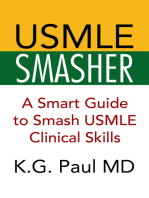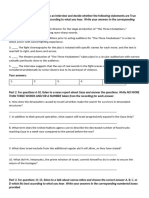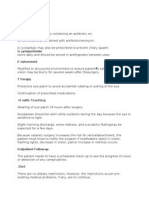09 Record Keeping
09 Record Keeping
Uploaded by
Mwanja MosesCopyright:
Available Formats
09 Record Keeping
09 Record Keeping
Uploaded by
Mwanja MosesOriginal Title
Copyright
Available Formats
Share this document
Did you find this document useful?
Is this content inappropriate?
Copyright:
Available Formats
09 Record Keeping
09 Record Keeping
Uploaded by
Mwanja MosesCopyright:
Available Formats
RECORD KEEPING
EST
AUTHOR (s)
Brien Holden Vision Institute Faculty: Jane Kierath, Sonja Cronjé, Neilsen de Souza, Shoshana Jackofsky,
David Wilson, Mitasha Marolia, Gerd Schlenther, Naomi Freuden, Peter Mohlala Brien Holden Vision Institute,
Sydney, Australia
REVIEWER (s)
Bob Chappell Past President: World Council of Optometry (WCO)
THINK
A child you saw two years ago has a scar on the cornea.
You need to know:
If this is a new or old scar?
If somebody else has examined the child before?
What tests were performed?
What the results were?
WHAT YOU WILL LEARN
When you’ll have worked through this unit you should be able to:
Recognise the importance of keeping a record
List the details that should be included in a record
RECORD KEEPING
A record is a document that provides information about a person’s eye test.
Records are important as they allow you to keep a permanent copy of what happened each time the person visited
you.
When the person has their eyes examined again in the future, the examiner will know if the person’s eyes are
getting better or worse.
Anyone who looks at a person’s record should be able to know what the person’s problems were and what was
done about them.
It is important that the information that is written on the record is written neatly and can be easily understood.
Record cards can be filed by name or by number.
June 2012, Version 1-1 Record Keeping, Chapter 9-1
Record Keeping
WHAT DO WE NEED TO RECORD
WHAT INFORMATION IS IN A RECORD?
The date of each visit
The person’s full name
DETAILS OF THE The person’s date of birth or age (if known)
PERSON: Male or female
Contact details (address, phone number)
Where you saw the person (name of hospital, clinic or other).
A summary of the information gathered about the patient
Chief complaint and history
Eye health and family history
CASE HISTORY:
General health and medication
Visual needs
Distance and near vision.
Visual Acuity measured at distance and near
VISUAL ACUITY: With their own spectacles (aided)
Without spectacles (unaided)
What you saw and did during the examination
EXAMINATION:
Details of the person’s eye health
What you identified to be the problem and how you intend to manage it
PLAN: Prescription of spectacles and medication
Referral
What you told the person
Explanation of their symptoms / your findings
Medication / treatment plan and why you have decided on this mode of action
ADVICE:
When to use the medication or follow the course of treatment
In cases of referral and explanation as to why they need to be referred and when
they need to return for a follow-up visit.
You must complete the record by printing and signing your name.
SIGNATURE
It is not a legal document unless it is signed by the examining practitioner
RECORD THE RESULT EVEN IF IT IS NORMAL
This means that you should write down positive findings as well as negative
findings e.g. distance vision is good or cornea is clear.
This shows that you have done the test.
If a box has been left empty on the record form, it means the test was not done.
June 2012, Version 1-1 Record Keeping, Chapter 9-2
Record Keeping
TEST YOURSELF QUESTIONS
1. Why is it important to keep good eye examination records?
_______________________________________________________________________________________
_______________________________________________________________________________________
_______________________________________________________________________________________
2. Why is it important that the information on the record card be written neatly?
_______________________________________________________________________________________
_______________________________________________________________________________________
_______________________________________________________________________________________
3. What information do we need to write in our record card about a person?
_______________________________________________________________________________________
_______________________________________________________________________________________
4. Why is it important to write down facts even if they are normal?
_______________________________________________________________________________________
_______________________________________________________________________________________
June 2012, Version 1-1 Record Keeping, Chapter 9-3
You might also like
- Raheel OSCE Notes January 2023Document453 pagesRaheel OSCE Notes January 2023KamleshKumar100% (2)
- An Introduction To Optometry: This Chapter Includes A Review ofDocument11 pagesAn Introduction To Optometry: This Chapter Includes A Review ofMwanja Moses100% (1)
- Ophthobook PDFDocument135 pagesOphthobook PDFl33t54r62No ratings yet
- Three-Stage Assessment. 2021Document14 pagesThree-Stage Assessment. 2021Mwanja Moses100% (1)
- Family-Oriented Primary CareDocument16 pagesFamily-Oriented Primary CareMwanja MosesNo ratings yet
- Manual of Eye Emergencies Diagnosis and ManagementDocument221 pagesManual of Eye Emergencies Diagnosis and ManagementPhilip McNelson100% (2)
- Caroline Christie - CET Dry EyeDocument4 pagesCaroline Christie - CET Dry EyeUmesh Kamath100% (1)
- l1 - Primary Eye CareDocument6 pagesl1 - Primary Eye Careteamtruth50No ratings yet
- 02 Patient Profile and Case HistoryDocument7 pages02 Patient Profile and Case HistoryNikoleta TuleaNo ratings yet
- 04 Taking A Case HistoryDocument10 pages04 Taking A Case HistoryMwanja MosesNo ratings yet
- Manual RefractionDocument36 pagesManual Refractionjzaib1154No ratings yet
- Laporan Sistem InderaDocument58 pagesLaporan Sistem InderaRoy KurniawanNo ratings yet
- VS Station ChecklistsDocument5 pagesVS Station Checklistsjayasharmasingh2000No ratings yet
- Case HistoryDocument32 pagesCase HistoryHogan ObiNo ratings yet
- ESTONILO, Katrina OphthaHistoryandPEDocument2 pagesESTONILO, Katrina OphthaHistoryandPEKat EstoniloNo ratings yet
- Po Semi Final 2021-2022Document2 pagesPo Semi Final 2021-2022Kwenzie FortalezaNo ratings yet
- PIIS0002939422003828Document7 pagesPIIS0002939422003828Anca Florina GaceaNo ratings yet
- EENMT_SC 3Document32 pagesEENMT_SC 3ameliamen06No ratings yet
- EENMT_SC 3Document32 pagesEENMT_SC 3ameliamen06No ratings yet
- Doctor and Patient:: General Principles of History TakingDocument12 pagesDoctor and Patient:: General Principles of History TakingVishal ParnerkarNo ratings yet
- HC Format OptometricDocument4 pagesHC Format OptometricScribdTranslationsNo ratings yet
- Eye ExamDocument12 pagesEye ExamQing Liang OngNo ratings yet
- Informed Consent HiligaynonDocument19 pagesInformed Consent HiligaynonLance FuentesNo ratings yet
- Module 1: Medical History Taking and Physical Examination: Elicits InformationDocument11 pagesModule 1: Medical History Taking and Physical Examination: Elicits InformationShami CustodioNo ratings yet
- 1 Acknowledgement 2 2 3 3 Signs and Symptoms 4 4 Pathophysiology 5 5 Real Cases A-Patient History B - Physical Examination 6-9Document22 pages1 Acknowledgement 2 2 3 3 Signs and Symptoms 4 4 Pathophysiology 5 5 Real Cases A-Patient History B - Physical Examination 6-9radicalmpNo ratings yet
- Health Assessment NotesDocument7 pagesHealth Assessment NotesShing Shang ShongNo ratings yet
- Opto PracDocument1 pageOpto Pracalwiugc.02No ratings yet
- Running Head: SOAP NOTE 1Document10 pagesRunning Head: SOAP NOTE 1Galatic JupiterNo ratings yet
- Proforma Ophthalmic HistoryDocument3 pagesProforma Ophthalmic Historymahir patelNo ratings yet
- Eye Eye Assessment Assessment and Care and CareDocument126 pagesEye Eye Assessment Assessment and Care and CareBern NerquitNo ratings yet
- Child Development Checker - Evaluation ResultsDocument3 pagesChild Development Checker - Evaluation ResultsNelly SernaNo ratings yet
- Basic Examination of StrabismusDocument72 pagesBasic Examination of Strabismusjessica bedoya restrepo100% (2)
- NEUROPrelims - History Taking in NeurologyDocument4 pagesNEUROPrelims - History Taking in NeurologyRenatoCosmeGalvanJuniorNo ratings yet
- Hey, Doc! What’S Wrong with My Eye?: A General Guide to Eye SymptomsFrom EverandHey, Doc! What’S Wrong with My Eye?: A General Guide to Eye SymptomsNo ratings yet
- Energetic EyeHealing: No Exercise Way of Improving VisionFrom EverandEnergetic EyeHealing: No Exercise Way of Improving VisionRating: 4 out of 5 stars4/5 (4)
- Joan (NARRATIVE REPORT)Document9 pagesJoan (NARRATIVE REPORT)jdduran092023No ratings yet
- Nursing Process Study Guide Packet 1 Exam 1Document13 pagesNursing Process Study Guide Packet 1 Exam 1Emily StoicovyNo ratings yet
- How To Measure Vision in Glaucoma: How Well Do Your PatientsDocument2 pagesHow To Measure Vision in Glaucoma: How Well Do Your PatientsUni AisNo ratings yet
- Ophthalmology History TakingDocument12 pagesOphthalmology History TakingRizki MeizikriNo ratings yet
- Development and Evaluation of A Measure of Patient-Reported Symptoms of BlepharitisDocument6 pagesDevelopment and Evaluation of A Measure of Patient-Reported Symptoms of BlepharitisYulia MagdalenaNo ratings yet
- Nonorganic Vision LossDocument8 pagesNonorganic Vision LossArdelia EmilyNo ratings yet
- Case Taking and Case HistoryDocument15 pagesCase Taking and Case Historythasneem4403No ratings yet
- Case StudyDocument23 pagesCase StudyFarah Jelimae BagniNo ratings yet
- Unit Two Basic Examination of The Eye: 2.1. History TakingDocument12 pagesUnit Two Basic Examination of The Eye: 2.1. History TakingiuytrerNo ratings yet
- Visual Acuity and Visual Acuity TestsDocument7 pagesVisual Acuity and Visual Acuity Testsmecoolboy82No ratings yet
- Nursing case study formatDocument4 pagesNursing case study formatPreeths RoshanNo ratings yet
- Sumi - Presentation On BlindnessDocument23 pagesSumi - Presentation On Blindnessabhigyan priyadarshanNo ratings yet
- Eye Exams For ChildrenDocument5 pagesEye Exams For ChildrenDanielz FranceNo ratings yet
- Optometric Case AnalysisDocument93 pagesOptometric Case AnalysisJoseph Israel100% (1)
- Academy Eye Care PDFDocument4 pagesAcademy Eye Care PDFCeyka MadumaNo ratings yet
- Diagnosis Dan Tatalaksana Pasien Dengan Insufisiensi Akomodasi - Sri Hudaya WidihasthaDocument13 pagesDiagnosis Dan Tatalaksana Pasien Dengan Insufisiensi Akomodasi - Sri Hudaya WidihasthamalaNo ratings yet
- Chapter 1 Eye History and PhysicalDocument3 pagesChapter 1 Eye History and PhysicalFarah FarahNo ratings yet
- Physical AssessmenDocument3 pagesPhysical AssessmenJohn Lawrence Fernandez EboNo ratings yet
- Downloadophthalmology Cases All Team PDF PDF Free - HTMLDocument23 pagesDownloadophthalmology Cases All Team PDF PDF Free - HTMLDương Yến TrânNo ratings yet
- IJCRR Nov2020 Vol12 Issue21Document7 pagesIJCRR Nov2020 Vol12 Issue21Aravind KumarNo ratings yet
- Health Assessment Unit 1Document15 pagesHealth Assessment Unit 1Victoria YuNo ratings yet
- OSCE - Team 3 BDocument6 pagesOSCE - Team 3 BStefanNo ratings yet
- Health AssessmentDocument50 pagesHealth AssessmentVineela KuchipudiNo ratings yet
- Assessment - of - SKIN HAIR AND NAILS CHECKLISTDocument8 pagesAssessment - of - SKIN HAIR AND NAILS CHECKLISTJonah R. MeranoNo ratings yet
- Manual of Eye Emergencies. Diagnosis and Management (2004)Document221 pagesManual of Eye Emergencies. Diagnosis and Management (2004)Claudia-Maria PopaNo ratings yet
- Baja Vision 2Document16 pagesBaja Vision 2Leyla Durgalli100% (1)
- A Course in Low Vision PracticeDocument12 pagesA Course in Low Vision PracticeDr. Candy Delos Reyes-BarluadoNo ratings yet
- 07 Crossed Eyes Nystagmus and AmblyopiaDocument7 pages07 Crossed Eyes Nystagmus and AmblyopiaMwanja MosesNo ratings yet
- Malaria in PregnancyDocument17 pagesMalaria in PregnancyMwanja MosesNo ratings yet
- Ectopic Pregnancy: Michelle Schroeder, MD Busitema University Faculty of Health SciencesDocument31 pagesEctopic Pregnancy: Michelle Schroeder, MD Busitema University Faculty of Health SciencesMwanja MosesNo ratings yet
- Principles of Family MedicineDocument13 pagesPrinciples of Family MedicineMwanja MosesNo ratings yet
- Medical Ethics and Professional Practice - Yr III and IVDocument52 pagesMedical Ethics and Professional Practice - Yr III and IVMwanja MosesNo ratings yet
- Introduction To Family Medicine - UpdatedDocument22 pagesIntroduction To Family Medicine - UpdatedMwanja MosesNo ratings yet
- List of Agencies With Recognition Status and ApplyingDocument6 pagesList of Agencies With Recognition Status and ApplyingMwanja MosesNo ratings yet
- Preterm Labor and Pprom: Michelle Schroeder, MD Busitema University Faculty of Health SciencesDocument39 pagesPreterm Labor and Pprom: Michelle Schroeder, MD Busitema University Faculty of Health SciencesMwanja MosesNo ratings yet
- Basic Infertility Workup: Michelle Schroeder, MD Busitema University Faculty of Health SciencesDocument36 pagesBasic Infertility Workup: Michelle Schroeder, MD Busitema University Faculty of Health SciencesMwanja MosesNo ratings yet
- Patient-Centred CareDocument15 pagesPatient-Centred CareMwanja MosesNo ratings yet
- 04 Taking A Case HistoryDocument38 pages04 Taking A Case HistoryMwanja MosesNo ratings yet
- Shock in Obgyn: Michelle Schroeder, MD Busitema University Faculty of Health SciencesDocument30 pagesShock in Obgyn: Michelle Schroeder, MD Busitema University Faculty of Health SciencesMwanja MosesNo ratings yet
- Introduction To Optometry: The Normal EyeDocument21 pagesIntroduction To Optometry: The Normal EyeMwanja MosesNo ratings yet
- Toxicology: DR Frank Kakuba G MD, Mmed Path (Mak)Document24 pagesToxicology: DR Frank Kakuba G MD, Mmed Path (Mak)Mwanja MosesNo ratings yet
- 11 Basic Ethics and ProfessionalismDocument7 pages11 Basic Ethics and ProfessionalismMwanja MosesNo ratings yet
- Medical Ethics and Professional Practice Yr III and IV - Lecture IIIDocument11 pagesMedical Ethics and Professional Practice Yr III and IV - Lecture IIIMwanja MosesNo ratings yet
- Nucleic Acid and Amio Acid Structure and FunctionDocument47 pagesNucleic Acid and Amio Acid Structure and FunctionMwanja MosesNo ratings yet
- An Introduction To Molecular Biology: Savannah Mwesigwa Adapted From Aala A. AbulfarajDocument25 pagesAn Introduction To Molecular Biology: Savannah Mwesigwa Adapted From Aala A. AbulfarajMwanja MosesNo ratings yet
- Internet Presentation TODAYDocument19 pagesInternet Presentation TODAYMwanja MosesNo ratings yet
- fDNA REPLICATION - TRANSLATION, TRANSCRIPTION, PROTEIN SYNTHESISDocument84 pagesfDNA REPLICATION - TRANSLATION, TRANSCRIPTION, PROTEIN SYNTHESISMwanja MosesNo ratings yet
- Certificate Proposal WritingDocument1 pageCertificate Proposal WritingMwanja MosesNo ratings yet
- 09 Blindness Prevention Role of Civil Society OrganisationsDocument3 pages09 Blindness Prevention Role of Civil Society OrganisationsMwanja MosesNo ratings yet
- 06 Refractive ErrorDocument12 pages06 Refractive ErrorMwanja MosesNo ratings yet
- 08 Vision ScreeningDocument4 pages08 Vision ScreeningMwanja MosesNo ratings yet
- 03 Vision 2020 The Right To SightDocument9 pages03 Vision 2020 The Right To SightMwanja MosesNo ratings yet
- 02 Introduction To The EyeDocument12 pages02 Introduction To The EyeMwanja MosesNo ratings yet
- Hubungan DM DGN Katarak 2021Document8 pagesHubungan DM DGN Katarak 2021Sirli RaraNo ratings yet
- ArtifactsDocument9 pagesArtifactsaya mahmoudNo ratings yet
- MSDS M-Kurita KF SBL-20 (R1) CasDocument2 pagesMSDS M-Kurita KF SBL-20 (R1) CasArief SetiawanNo ratings yet
- Tamilnadu Medical College ListDocument6 pagesTamilnadu Medical College Listsyed.kwfNo ratings yet
- MSDS 2x SYBR Green QPCR Master MixDocument6 pagesMSDS 2x SYBR Green QPCR Master MixkokoNo ratings yet
- Behavioural OptometryDocument2 pagesBehavioural OptometryTarun Dutta - HritNo ratings yet
- NA 01-H1AAC-6-3 AH-1W Scheduled Maintenance Requirement CarDocument258 pagesNA 01-H1AAC-6-3 AH-1W Scheduled Maintenance Requirement CarΠΑΝΑΓΙΩΤΗΣ ΑΝΑΟΥΝΗΣNo ratings yet
- Barriers To Eye Care ForDocument1 pageBarriers To Eye Care ForEunice DichosoNo ratings yet
- MSDS Nalcool 2000 PDFDocument7 pagesMSDS Nalcool 2000 PDFMiguel AngelNo ratings yet
- Gems of Ophthalmology - RetinaDocument444 pagesGems of Ophthalmology - RetinaoptilabriberosNo ratings yet
- Dr. Ashraf Sayeed: Department of OphthalmologyDocument49 pagesDr. Ashraf Sayeed: Department of Ophthalmologysaiful haque100% (1)
- Revision Mcqs MCQS: Professor Osama ShalabyDocument161 pagesRevision Mcqs MCQS: Professor Osama ShalabyAhmed YounisNo ratings yet
- Rajaram Eye CareDocument17 pagesRajaram Eye CareAnuj sharmaNo ratings yet
- List of Chemical With MSDS Updated 2023Document285 pagesList of Chemical With MSDS Updated 2023REHAN IQBALNo ratings yet
- Visual Acuity Test: Equipment NeededDocument3 pagesVisual Acuity Test: Equipment Neededmelannie napisaNo ratings yet
- Neocerebellar SyndromeDocument14 pagesNeocerebellar Syndromegoldengoal19079No ratings yet
- SDS - Paint - ACRY-PUR 902-GDocument14 pagesSDS - Paint - ACRY-PUR 902-GfmblocationNo ratings yet
- Testing Cranial Nerves Activity SheetDocument5 pagesTesting Cranial Nerves Activity Sheetapi-438810380No ratings yet
- MODULE 6 Sir RobertDocument17 pagesMODULE 6 Sir RobertManilyn DominguezNo ratings yet
- MSDS-MDT Plus 4 2017Document2 pagesMSDS-MDT Plus 4 2017Ade IrawanNo ratings yet
- VitriolageDocument3 pagesVitriolageSandeep BansalNo ratings yet
- Using The Pentacam™ Calculation: For IOL PowerDocument4 pagesUsing The Pentacam™ Calculation: For IOL PowerGerardo Felipe Mora ZepedaNo ratings yet
- Mecca Iclininc Foundation Inc.: Dr. Jesa ProtasioDocument2 pagesMecca Iclininc Foundation Inc.: Dr. Jesa ProtasioWilliam SmithNo ratings yet
- Insitu: Formulation and Evaluation of Ocular Hydrogels of AcyclovirDocument9 pagesInsitu: Formulation and Evaluation of Ocular Hydrogels of Acyclovirazita nezamiNo ratings yet
- Risk Assessment/JHA Form: Hot WorkDocument16 pagesRisk Assessment/JHA Form: Hot WorkmuradNo ratings yet
- A Seminar Report OnDocument6 pagesA Seminar Report OnHimanshu PatelNo ratings yet
- ĐỀ CHỌN ĐT QGDocument14 pagesĐỀ CHỌN ĐT QGthao.apple2003No ratings yet
- Repair of Eyelid Laceration: Dr. Rashmi Joshi DNB Student BceircDocument49 pagesRepair of Eyelid Laceration: Dr. Rashmi Joshi DNB Student BceircPraful ChaudharyNo ratings yet
- Cataract Discharge PlanDocument2 pagesCataract Discharge PlanLeah GordoncilloNo ratings yet
- Intro To Psych Module 3Document18 pagesIntro To Psych Module 3GinelQuenna De VillaNo ratings yet






















































































































